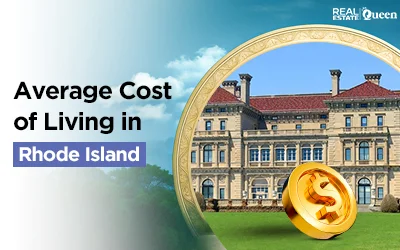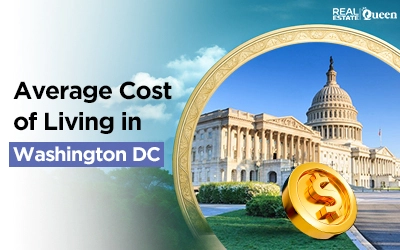
Considering a move to South Dakota? With its friendly communities and dynamic metro areas like Sioux Falls and Rapid City, it’s easy to see the appeal. The average cost of living in South Dakota is well below the national average, with an index of 91.2, making it more affordable than most states.
As a result, South Dakota stands out among regional peers. From housing and groceries to utilities and childcare, the average cost of living in South Dakota is one of the most reasonable in this part of the country. Here’s a closer look at what expenses to expect, including rent, food, transportation, and more.
TL;DR: Average Cost of Living in South Dakota 2025
- Cost-of-living index: 91.2 (US average = 100)
- Annual personal consumption: $48,997 per resident
- Required salary (single): $48,000–$50,000
- Required salary (family of four): $80,000–$100,000
- Median 1BR Rent: $704/month
- Median Home Price: $325,700–$360,800
- Average Utilities: $408–$551/month
- Groceries: $256–$286/month per person
- Public Transportation: $50/month
Understanding South Dakota’s Cost of Living
South Dakota offers a cost advantage compared to nearby states. To live comfortably, single adults need about $48,000–$50,000 each year. Families of four should plan for $80,000–$100,000.
Meanwhile, these are the main monthly living expenses statewide:
- Rent: $704 for a one-bedroom apartment
- Utilities: $408–$551 each month, among the lowest regionally
- Groceries: $256–$286 per person
- Transportation: $50 for public transit; gas prices close to the national average
- Healthcare (Silver plan): $715 per month
- Daycare: $8,283 per year; Preschool: $6,302 per year
In addition, the average cost of living in South Dakota extends across key regions. For example, Sioux Falls offers great career opportunities, while Rapid City features lower home prices.
Average Rent and Housing Costs in South Dakota
South Dakota’s housing market is one of the biggest factors behind the state’s overall affordability.
The average rent in South Dakota is $704 for a one-bedroom, much lower than in most states in the north central region. Median home prices range from $325,700 to $360,800. These prices put South Dakota in the middle tier regionally, yet still more affordable than Minnesota.
Comparing Home and Rent Prices
- North Dakota: 1BR rent $843; median home $278,983–$306,667 (12–17% lower than SD)
- Nebraska: 1BR rent $893; median home $297,333–$355,766 (8–10% lower than SD)
- Minnesota: 1BR rent $1,127; median home $356,633–$363,400 (2–12% higher than SD)
- Wyoming: Cheyenne/Casper rent $850–$1,200; homes $319,000–$435,000 (2% lower to 21% higher than SD)
For instance, Sioux Falls has seen rising home values, but Rapid City remains more budget-friendly. Most towns outside these two hubs have even lower rents.
👉 Looking for homes for sale in South Dakota that match your budget? Discover the latest listings with advanced search filters and sorting options on Houzeo, America’s best home buying website.
Utilities and Other Expenses in South Dakota
Utilities are also budget-friendly in South Dakota. Most households spend between $408 and $551 per month on electricity, water, and gas. Only Wyoming is often lower, while Minnesota’s utility bills, for example, average $631 monthly.
Utility Cost Comparison (Per Month)
- North Dakota: $320–$396
- Nebraska: $379–$560
- Minnesota: $631
- Wyoming: $538
In addition, grocery costs in South Dakota are the lowest among its neighbors. People spend just $256–$286 per month on groceries.
Grocery Expenses Across Peer States (Monthly Per Person)
- South Dakota: $256–$286
- North Dakota: $326
- Nebraska: $336
- Minnesota: $310+
- Wyoming: $409
For transportation, expect to pay just $50 a month for public transit. Gas prices remain close to the national average.
Healthcare premiums for employer plans run about $139.67 monthly, and Silver health plans cost $715 monthly. South Dakota’s healthcare costs are similar to North Dakota, with slightly higher premiums than in Nebraska.
Income and Job Market in South Dakota
In South Dakota, salaries match the cost of living well. Single adults need about $48,000–$50,000 to maintain a middle-class lifestyle. However, families of four should target $80,000–$100,000.
Median incomes and job options compete with Nebraska and Wyoming. On the other hand, Minnesota usually requires higher average wages to keep pace with big-city living costs.
Is South Dakota Worth It?
For most people, South Dakota offers great value. The average cost of living in South Dakota means you get stable finances, easy access to amenities, and a high quality of life. Public schooling is good, and local services in towns like Aberdeen and Brookings are well-rated.
The state provides affordable childcare, reliable public transportation, and manageable healthcare premiums. As a result, South Dakota appeals to professionals, families, and retirees who want their dollar to go further.
Regional Insights and Practical Relocation Tips
- Sioux Falls: Growing job market, affordable rent, and lively downtown.
- Rapid City: Cheaper homes, proximity to outdoor recreation, and plenty of entry-level opportunities.
- Brookings or Aberdeen: Active college towns, lots of cultural events, and competitive prices.
- Watertown: Peaceful living, lower cost housing, and job options nearby.
For best results, new residents should look for neighborhoods near work and schools. That way, you minimize commuting costs and get the most out of the average cost of living in South Dakota.
Conclusion
Overall, the average cost of living in South Dakota beats regional competitors in almost every category. Housing, groceries, utilities, and childcare cost less than in North Dakota, Nebraska, Minnesota, or Wyoming.
While health coverage can be pricey in certain plans, most living expenses are fair. For anyone seeking value and comfort, South Dakota is a smart pick.
👉 Browse the latest South Dakota homes for sale on Houzeo and match your budget with your dream neighborhood.
FAQs About South Dakota’s Average Cost of Living
Is the average cost of living in South Dakota higher than Nebraska or North Dakota?
No, South Dakota's average cost of living is not higher than in Nebraska or North Dakota. The state is more affordable for rent, groceries, utilities, and childcare compared to nearby states.
What is the average rent in South Dakota?
The average rent in South Dakota for a one-bedroom apartment is about $704 per month, which is well below the regional average.
How much money do I need to live comfortably in South Dakota?
You need about $48,000 to $50,000 per year as a single adult to live comfortably in South Dakota, while a family of four typically needs between $80,000 and $100,000.
Which regions offer the lowest average cost of living in South Dakota?
Small towns and rural areas—especially those outside Sioux Falls and Rapid City—offer the lowest cost of living in South Dakota.
Are groceries and utilities affordable in South Dakota compared to other states?
Yes, groceries and utilities in South Dakota are affordable compared to other states. These expenses are generally the lowest among neighboring regions.






